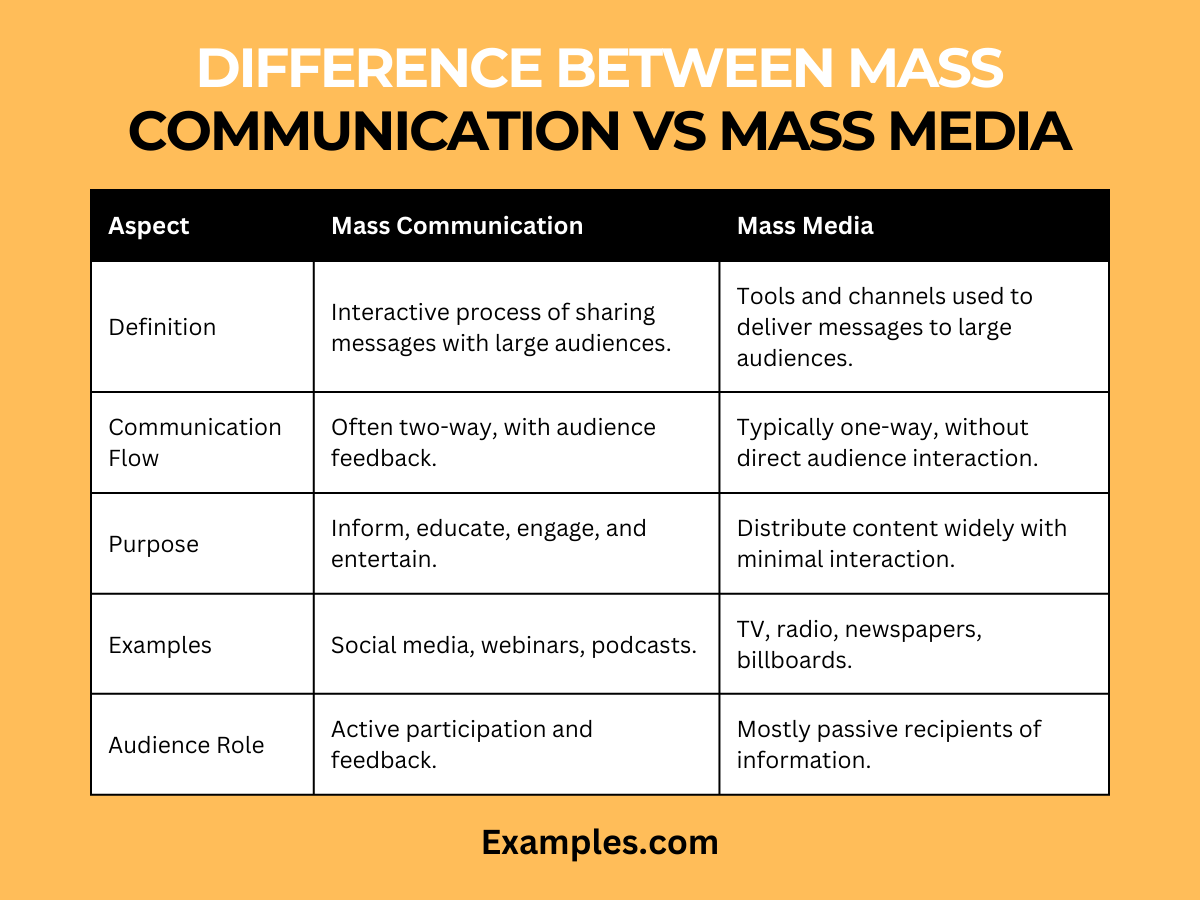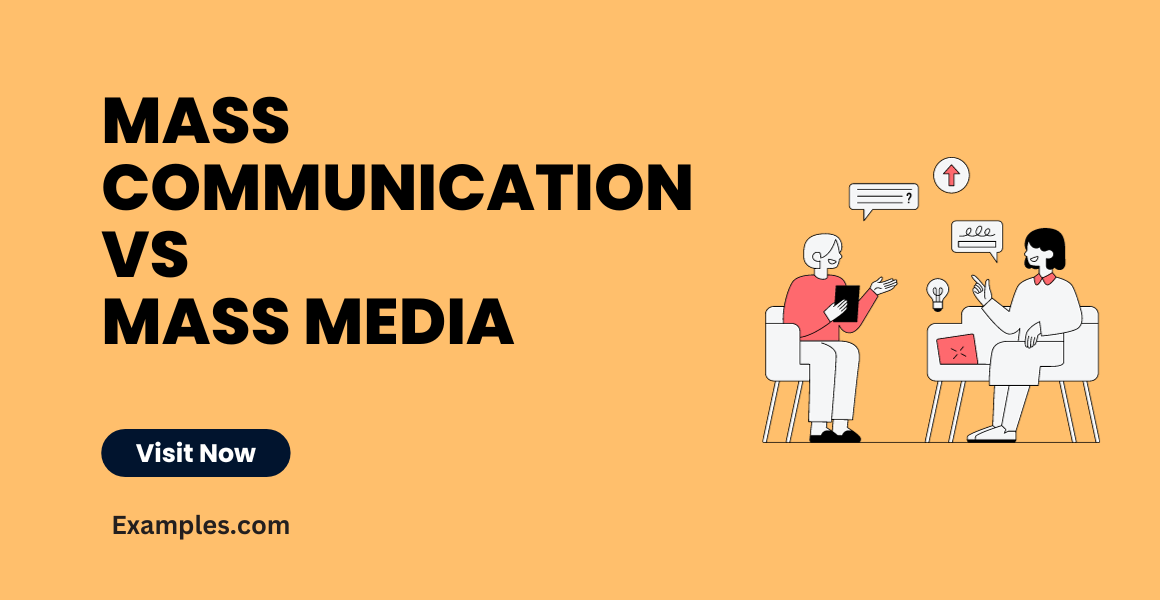Mass Communication vs Mass Media – 49+ Examples
In this comprehensive guide, we delve into the intricate relationship between Mass Communication and Mass Media, two pivotal facets of modern information dissemination. We explore their unique characteristics, interplay, and impact on society, backed by practical Mass Communication Examples. This exploration sheds light on how each field operates within the digital era, highlighting their roles in shaping public discourse and influencing societal norms. Join us as we unravel these dynamic domains through vivid examples and insightful analysis.
Difference Between Mass Communication vs Mass Media
In the fast-paced world of information technology, understanding the nuances between Mass Communication and Mass Media is essential. This guide delves deep into the distinctions, functionalities, and impacts of these two interconnected yet distinct fields. By breaking down their characteristics, we can better comprehend how they shape our understanding of the world and influence the ways we communicate and consume information.

| Aspect | Mass Communication | Mass Media |
|---|---|---|
| Definition | Involves the process of creating, sending, receiving, and analyzing messages to large audiences via verbal and non-verbal means. | Refers to the tools or technologies used to deliver communication to large audiences, like TV, radio, newspapers, and the internet. |
| Communication Flow | Interactive and often two-way, allowing feedback and engagement from the audience. | Typically one-way, transmitting information without direct interaction from the audience. |
| Purpose | Aims to inform, educate, persuade, or entertain, but with a focus on the relationship and interaction with the audience. | Primarily focuses on content distribution and delivery to a wide audience with minimal interaction. |
| Examples | Social media campaigns, online forums, public relations, educational webinars, and podcasts. | Television shows, radio broadcasts, newspapers, magazines, and billboards. |
| Audience Engagement | Encourages active participation and feedback from the audience. | The audience is usually passive recipients of information. |
| Content Creation | Content is often tailored to foster interaction, dialogue, and engagement. | Content is designed for mass appeal, often standardized for broad audiences. |
| Technological Use | Utilizes various digital platforms and tools to create an interactive environment. | Involves traditional and modern media channels for content dissemination. |
| Impact on Society | Focused on building communities and facilitating discussion and learning. | Concentrated on information broadcasting and shaping public opinion. |
| Professional Roles | Involves roles like social media manager, public relations officer, and content creator. | Includes roles like journalist, broadcaster, and advertising executive. |
50 Examples of Mass Communication vs Mass Media
Exploring the world of Mass Communication and Mass Media reveals a diverse range of methods used to disseminate information and engage with audiences. From interactive digital platforms to traditional broadcasting channels, these 50 unique examples provide a deeper understanding of how each medium operates and impacts its audience. Detailed explanations and communication strategies for each example illustrate the nuances and effectiveness of different approaches in the digital age.
Mass Communication Examples
- Social Media Campaigns: Platforms like Facebook and Twitter allow for two-way engagement, fostering community building and direct audience interaction.
How to Communicate: Develop interactive content and respond to comments to create a lively community. - Corporate Webinars: These online seminars enable real-time interaction, making them ideal for targeted audience education and engagement.
How to Communicate: Encourage participation through live Q&A sessions and interactive polls. - Email Newsletters: Personalized newsletters offer a direct line of communication, tailored to the interests of the subscriber.
How to Communicate: Use engaging subject lines and include calls-to-action prompting readers to respond or interact. - Public Relations Events: These events create opportunities for direct engagement with media and public, enhancing brand image.
How to Communicate: Facilitate interactive sessions like Q&As and use social media for live updates. - Online Discussion Forums: Forums encourage knowledge exchange on specific topics, moderated to maintain constructive dialogue.
How to Communicate: Actively participate in discussions and encourage diverse viewpoints. - Podcasts on Current Affairs: Podcasts invite audience interaction, such as listener polls or call-in segments, enriching the discussion.
How to Communicate: Invite listeners to submit questions or comments for upcoming episodes. - Crowdfunding Campaigns: These platforms present ideas to the public, seeking participation in the form of funding and feedback.
How to Communicate: Use compelling storytelling to connect with potential backers and provide regular updates. - Interactive Digital Billboards: These billboards engage passersby through interactive features, creating memorable experiences.
How to Communicate: Incorporate touch or motion-sensing technology for interactive advertisements. - YouTube Educational Series: YouTube allows creators to educate while encouraging viewer interaction through comments and likes.
How to Communicate: End videos with questions to spark discussions in the comment section. - Influencer Collaborations on Instagram: Influencers interact with their followers, creating a dialogue around promoted products.
How to Communicate: Use engaging captions and stories to encourage followers to comment and share.
Mass Media Examples
- National Television News Broadcasts: These broadcasts provide widespread news coverage, offering information without direct interaction.
How to Communicate: Focus on clear, unbiased reporting to maintain credibility and trust. - Radio Music Stations: They broadcast music and entertainment to a broad audience, primarily serving as a one-way communication channel.
How to Communicate: Choose playlists that cater to the preferences of the majority of listeners. - Cinema Advertising: These ads leverage the captive audience in cinemas, providing one-way communication without feedback.
How to Communicate: Create visually captivating and memorable adverts to capture the audience’s attention. - Printed Newspapers: Newspapers distribute news in a traditional format, focusing on delivering content without expecting feedback.
How to Communicate: Use engaging headlines and ensure factual accuracy to retain reader trust. - Magazine Lifestyle Features: Magazines offer in-depth insights on various topics, aimed at a passive readership.
How to Communicate: Utilize high-quality imagery and engaging narratives to enhance reader interest. - Documentary Films on Streaming Services: These provide thorough exploration on specific subjects, intended for education and information.
How to Communicate: Craft compelling storytelling and factual accuracy to educate and engage viewers. - Outdoor Billboards: Billboards display advertisements in public spaces, reaching a broad audience in a non-interactive manner.
How to Communicate: Design bold and clear visuals to quickly convey the message to passersby. - Press Releases: These distribute information to various media outlets, targeting a wide but passive audience.
How to Communicate: Write concise, newsworthy content to capture media and public interest. - Book Publishing: Books present written content for consumption without immediate feedback or interaction.
How to Communicate: Focus on strong narrative and thematic coherence to engage readers. - Broadcasting Sports Events: Live sports events reach wide audiences, offering entertainment without direct viewer interaction.
How to Communicate: Provide engaging commentary to enhance the viewing experience.
Comparison Between Mass Communication and Mass Media
The distinction between Mass Communication and Mass Media is a fundamental aspect of modern journalism and media studies. This guide provides an in-depth comparison of these two crucial concepts, especially focusing on their relevance and application in journalism. By exploring Mass Communication Examples in Journalism, we can appreciate how each domain influences the way information is conveyed and received. This comparative analysis, presented in a table format, aims to clarify the nuances and unique attributes of Mass Communication and Mass Media, enhancing understanding for professionals, students, and enthusiasts alike.
Table of Comparison
| Aspect | Mass Communication | Mass Media |
|---|---|---|
| Definition | Refers to the process of creating, sending, receiving, and analyzing messages to large audiences. | Encompasses the tools and platforms used to convey messages to large audiences. |
| Nature of Communication | Interactive and often involves a two-way exchange. | Typically one-way, focusing on broadcasting information. |
| Key Focus | Engages in dialogue and building relationships with the audience. | Disseminates information, news, and entertainment. |
| Mediums | Social media, blogs, podcasts, webinars. | Television, radio, newspapers, magazines, films. |
| Audience Engagement | High, with active audience participation and feedback. | Generally passive, with limited direct audience interaction. |
| Content Approach | Tailored and can be personalized to suit specific audience segments. | Broad and designed to appeal to a wide audience. |
| Examples in Journalism | Interactive news websites, online forums, journalist-led podcasts. | News broadcasts, print journalism, documentary films. |
| Objective | To inform, educate, and initiate discussions, fostering community interaction. | To inform and entertain a wide audience with standardized content. |
| Technological Utilization | Makes extensive use of digital and social media technologies. | Relies on traditional and modern broadcasting and printing technologies. |
| Impact on Society | Encourages democratic participation, community building, and informed discussions. | Shapes public opinion, cultural norms, and provides a common knowledge base. |
Functions and Theories of Mass Communication vs Mass Media
In the dynamic fields of Mass Communication and Mass Media, understanding their functions and underlying theories is crucial, especially when considering Mass Communication Examples in Journalism. This comprehensive guide delves into the core functionalities and theoretical frameworks governing these sectors, shedding light on their unique roles in information dissemination and societal influence. By exploring these aspects, we gain insight into the powerful impact these fields have on shaping public opinion and media landscapes.

Functions of Mass Communication
Mass Communication is characterized by its interactive nature and its focus on two-way communication processes. It plays a vital role in:
- Information Dissemination: Disseminating news and information to the public, often incorporating feedback mechanisms.
- Education and Awareness: Educating the public on various issues, utilizing platforms like news articles and documentaries.
- Public Opinion Formation: Influencing public opinion through persuasive content, such as editorials and opinion pieces.
- Cultural Transmission: Aiding in the transmission of cultural values and norms through media representations.
- Entertainment: Providing entertainment to the public through diverse media formats, including online content and TV shows.
Theories in Mass Communication
Several theories help to understand the impact and methodology of Mass Communication:
- Agenda-Setting Theory: This theory suggests that the media doesn’t tell people what to think, but rather what to think about, playing a critical role in shaping the public agenda.
- Spiral of Silence Theory: This concept implies that people tend to remain silent when they believe their views are in the minority, which can be influenced by media portrayal of public opinion.
- Uses and Gratifications Theory: This theory explores how individuals use media to satisfy their needs, whether for information, personal identity, integration, or entertainment.
- Two-Step Flow Theory: It emphasizes that media effects often flow through opinion leaders, who then pass on their interpretation of media messages to others.
Functions of Mass Media
Mass Media, on the other hand, refers to the channels or technologies used for Mass Communication. Its primary functions include:
- Broadcasting Information: Distributing information to a wide audience via channels like television, radio, and newspapers.
- Mass Advertising: Serving as a platform for mass advertising, reaching a vast audience quickly and effectively.
- Standardizing News: Standardizing and packaging news and information for public consumption.
- Entertainment: Providing entertainment to a broad audience, often through non-interactive media like movies and TV series.
- Public Service Announcements: Disseminating public service announcements to educate and inform the public on various issues.
Theories in Mass Media
Theories specific to Mass Media help explain its influence on society:
- Hypodermic Needle Theory: This early theory suggested that media messages are injected directly into the passive audience, causing immediate effects.
- Cultivation Theory: It proposes that long-term exposure to media content, especially television, shapes viewers’ perceptions of reality.
- Limited Effects Theory: It argues that media’s influence is often limited by individual differences, social categories, and personal relationships.
- Media Dependency Theory: This theory suggests that the more a person relies on media to meet their needs, the more influence that media will have on them.
- Gatekeeping Theory: It focuses on how media content is filtered, shaped, and controlled by media professionals before reaching the audience.
Does Mass Communication Equal Mass Media?
In the sphere of information dissemination, a common question arises: Does Mass Communication equal Mass Media? This guide is specifically optimized for understanding this distinction with a focus on Mass Communication Examples in Journalism. It’s crucial to unravel these concepts as they are often mistakenly used interchangeably, yet they hold distinct meanings and implications in the field of journalism and beyond.
Mass Communication refers to the process of conveying messages to a large audience through various channels. It’s an umbrella term that encompasses the creation, sending, receiving, and analyzing of messages. In journalism, this involves not just the content creation but also the strategies and methods used to engage with the audience. It’s about the interaction between the message, the medium, and the audience.
Examples in journalism include interactive news websites where readers can comment on articles, social media platforms used by news agencies to engage with their audience, and email newsletters that provide personalized news content.
Mass Media, on the other hand, refers to the tools or channels used for mass communication. This includes television, radio, newspapers, magazines, and digital platforms. In journalism, mass media are the platforms through which news and information are distributed to the public. They represent the technical aspect of communication, serving as the conduit for conveying messages created by journalists.



